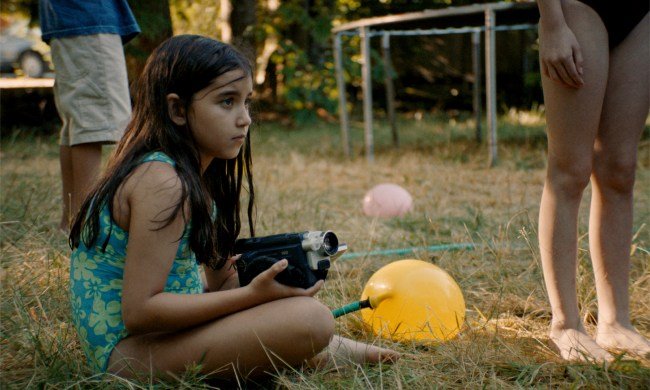Sophy Romvari’s Outstanding Debut Feature

[ad_1]

Perhaps it’s attributable to the lack of tactility of living in a digital hellscape, but a recent spate of thirtysomething filmmakers have been drawn to analogue media and textures in order to muse on a universal experience that no one ever quite processes in the same way: grief. “Aftersun” is but the most prominent example of a trend that memorably continued with Courtney Stephens’ “Invention” earlier this year, in which actor/writer Callie Hernandez fictionalized the aftermath of her father’s death with an assist from the VHS recordings of his many TV appearances dating back to the ’90s.
Seeming to pick up where that movie left off, Sophy Romvari’s “Blue Heron” similarly follows a protagonist as she navigates her pre-millennial childhood memories through a sea of camcorder clips and hazy recollections. But it would be reductive to belabor the comparisons any further than that, as the Canadian-Hungarian filmmaker’s extraordinary debut feature defies any clear precedent or easy categorization as it ventures down structurally exciting and unexpected paths.
While “Blue Heron” is a drama that works without any knowledge of the filmmaker’s history, Romvari’s feature is also the culmination of a decade-long journey. An international festival favorite since the mid-2010s, her acclaimed shorts regularly fall somewhere between fiction and autobiography, the latter to varying levels of overtness. In the likes of “Still Processing”, Romvari herself is the primary onscreen presence. That particular short from 2020, which grappled with the loss of her brothers by sifting through a box of family photos that had been unseen for decades, shares the most DNA with “Blue Heron,” though Romvari is strictly behind the camera this time.
For her fiction feature, she deploys an onscreen avatar. Or two. Possibly three, depending on how you interpret one specific dramatic set piece. It’s a thrilling formal expansion for a filmmaker who’s already so sharp in examining fragmented identities, and how they might be restored with a greater understanding of how the cracks came to be — even if restoration can be an incomplete process, and “greater” often means that a considerable amount of explanation and potential catharsis remain out of reach.
The opening words from an offscreen voice (Amy Zimmer) set the mood, hint at who we should keep an eye on for much of the movie, and gesture towards whose perspective we may be sharing along the way. “It’s true I spent a lot of my life angry at him,” she says. “The older I get, the less it feels like I knew him at all… Thank you for the memories. They’re all I have now.”
Credits play out over snapshots of a teenager’s hand-drawn maps that reference such locations as “Fantasyville”. Outside of “Blue Heron,” these are maps that one of Romvari’s own brothers created in his youth. Within the film, they are the work of Jeremy (Edik Beddoes), the teenage sibling of eight-year-old Sasha (Eylul Guven) — Henry (Liam Serg) and Felix (Preston Drabble) are the other brothers in the mix. In this Canada of the late 90s, their Hungarian immigrant family is moving into a new home on Vancouver Island. But there are complications within this attempt at a fresh start.
For one thing, Father (Ádám Tompa), the breadwinner of the family, quickly begins spending all his time between his dark room and his bulky work computer, leaving Mother (Iringó Réti) to take the lead for entertaining their kids when they’re not in school. Secondly, the new home only seems to exacerbate ongoing issues with the troubled Jeremy. Largely silent for the entire runtime despite people’s attempts to address or engage with him, the lanky teen exhibits increasingly erratic, sometimes dangerous behavior: from shoplifting and vanishing from his family during a rainstorm, to stomping on the house roof and punching through a window in the middle of the night.

Despite Sasha making friends in town, Mother discourages her from inviting them to their house, lest gossip about her brother spread and cause her to become socially isolated — a growing concern for an immigrant parent who wants her child to live peacefully in suburbia. As hinted by the maps of imaginary places that he has pinned in his bedroom, Jeremy operates by the logic of an inner world that no one else can seem to access. His parents try. Medical consultants can’t pinpoint what’s behind his outbursts. It’s getting to the point where his mysterious behavior is a safety concern for the other children, though he’s not necessarily ever aiming its more physical manifestations towards them.
Romvari, crucially, does include a number of little moments — mainly looks and gradual smiles — that suggest some clear affection from Jeremy towards his younger siblings. During one beach outing where Jeremy otherwise separates himself from his family during the trip, the teen briefly mock-threatens to step on a collection of stones and shells that Sasha has stacked, before gifting her a blue heron keychain to place atop it — a coveted prize from one of his many shoplifting attempts.
While the film isn’t exclusively told from Sasha’s perspective, it’s through her eyes and ears that we witness a lot of the major incidents with Jeremy, plus many of the conversations between their parents. Romvari often eschews traditional point-of-view shots, and cinematographer Maya Bankovic complements that decision by favoring a long-lens shooting style with occasional zooms. The location choices and production design work of Victoria Furuya are likewise in perfect harmony with Bankovic’s framing and movements. There’s an intimate tension to how the blocking sometimes makes it seem like the home has no walls, except when a specific scene calls for interaction with such a surface, like Sasha peeking through a slightly ajar door as her parents meet with a social worker or Jeremy incessantly slamming a basketball against the side of the house.
We also see conversations Sasha certainly couldn’t have been there to see for herself, and where she definitely isn’t present somewhere in the given onscreen space. This element of imagining discussions between her parents, rather than recreating memories of overheard thoughts or explicitly recorded events (Father is regularly shown using his camera and camcorder), ties into “Blue Heron”‘s second-half change-up, which is where the film really becomes something very special. Part of what works so well about the movie’s back half lies in its multiple disorientating swerves, so the specifics are best left unspoiled beyond saying that there’s a time jump to twenty-ish years later, with that opening adult voice (Amy Zimmer) being more explicitly confirmed as the grown-up version of Sasha, now a filmmaker who’s trying to process what happened to her big brother via her chosen artistic field.
It’s through Romvari and editor Kurt Walker’s bold structural move that the film, already excellent as “just” an observational portrait of a family in crisis, becomes profoundly moving. Romvari’s preoccupation with fractured identities ambitiously expands to reflect how our incomplete memories can be filled in over time — less through unlocking something we’d forgotten than by achieving a greater understanding of, and empathy for, the perspectives of those with whom we shared those times. If you’ve ever imagined how you’d try comforting your younger self or your family about the uncertain future ahead of them, “Blue Heron” may be the most emotionally devastating film of the year — and also perhaps the most comforting.
Grade: A-
“Blue Heron” premiered at the 2025 Locarno Film Festival. It is currently seeking U.S. distribution.
Want to stay up to date on IndieWire’s film reviews and critical thoughts? Subscribe here to our newly launched newsletter, In Review by David Ehrlich, in which our Chief Film Critic and Head Reviews Editor rounds up the best new reviews and streaming picks along with some exclusive musings — all only available to subscribers.
[ad_2]
Source link







